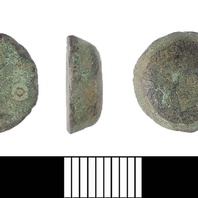
Viking Objects
Circular Weight (LIN-F9FD63)
This copper-alloy weight is decorated with a central punched ring-and-dot motif surrounded by a band of five further ring-and-dot motifs. Weights are an important form of evidence for Viking Age commerce and the use of standards across the different economic systems within which Vikings were integrated. Many of the weights discovered, particularly ones in Ireland and those of Arabic type, suggest that a standardized system of weights existed in some areas. These standard weights, alongside standard values of silver, are what allowed the bullion economy of Viking-occupied areas to function. A bullion economy was a barter economy that relied on the exchange of set amounts of precious metal in various forms, such as arm-rings or coins, for tradeable goods, such as food or textiles. Each merchant would have brought their own set of weights and scales to a transaction to make sure that the trade was conducted fairly.
Read More
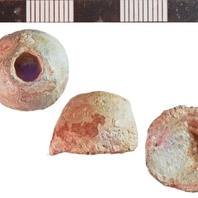
Viking Objects
Lead Weight (NLM-20FC79)
This cast lead weight has an empty apical hole which may have held something at some point. The mass may suggest this to have represented four Viking age units of 4.07gms, as used for silver bullion transactions. It is also possible that this object was used as a gaming piece and thus it could have served a dual purpose. Weights are an important form of evidence for Viking Age commerce and the use of standards across the different economic systems within which Vikings were integrated. Many of the weights discovered, particularly ones in Ireland and those of Arabic type, suggest that a standardized system of weights existed in some areas. These standard weights, alongside standard values of silver, are what allowed the bullion economy of Viking occupied areas to function. A bullion economy was a barter economy that relied on the exchange of set amounts of precious metal in various forms, such as arm-rings or coins, for tradable goods, such as food or textiles. Each merchant would have brought their own set of weights and scales to a transaction to make sure that the trade was conducted fairly.
Read More
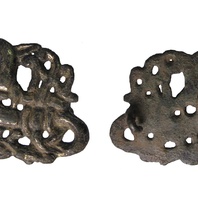
Viking Objects
Urnes-Style Brooch (LIN-F79A53)
This brooch has a gilded openwork zoomorphic design in the Urnes style. For more information on Scandinavian jewellery in England check out our blog: Brooches, Pendants and Pins: Scandinavian Dress Accessories in England.
Read More
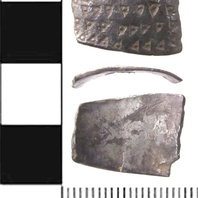
Viking Objects
Silver Arm Ring Fragment (SWYOR-58AFB4)
A fragment of an Early Medieval silver decorated arm ring with triangular punches each with a pellet in the centre. The object may represent hacksilver, but as it is broken rather than cut, this is not certain. Nonetheless, arm rings functioned as both a means of storing wealth as well as putting the wealth and status of the individual on display.
Read More
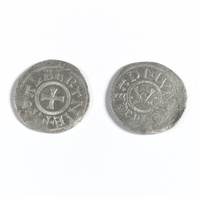
Viking Objects
Reproduction Viking Silver Penny
This reproduction of a Viking silver penny immitates those minited bu the Vikign rulers of York in the tenth century. Viking rulers in the Danelaw eventually took up the Anglo-Saxon practice of minting coins which helped legitimise their authority.
Read More
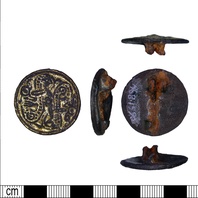
Viking Objects
Copper-Alloy Jellinge-Style Brooch (LEIC-36241D)
This brooch contains two S-shaped zoomorphic Jellinge-style designs around a central boss. For more information on Scandinavian jewellery in England check out our blog: Brooches, Pendants and Pins: Scandinavian Dress Accessories in England.
Read More
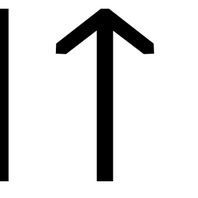
Viking Names
Ketil
The Old Norse male name Ketill is widely used across the Scandinavian world, including the Viking diaspora. It is also common as an element in compound names such as Grímketill (in later times usually appearing in a reduced form as Grímkell) or Ketilbjörn. In place-names it occurs for example in Kedleston, Derbyshire, Ab Kettleby, Leicestershire and several names in Lincolnshire such as Ketsby and Kettlethorpe. The name is identical to the common noun ketill meaning ‘kettle, cauldron’, which is a loan-word from Latin catillus (a ‘small basin’ or ‘bowl’) in Germanic languages. This suggests it was originally a by-name and there are many suggestions as to how such a by-name might have come about, including because someone had a head shaped like a cauldron, or wore a cauldron-shaped helmet, or engaged in ritual activities using a cauldron. In any case, by the Viking Age it is well established as a given name, without obvious reference to its meaning. The element is frequent in the Danelaw, both as a name and as the first element of place-names. Occasionally, the place-names may contain the Old English cognate cetel/cietel/cytel, used topographically for a deep valley surrounded by hills, and often associated with springs or streams. Its use as a personal name, however, seems to have been introduced by the Scandinavians.
Read More
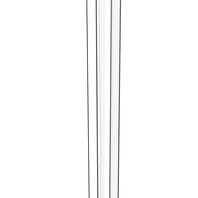
Viking Designs
Drawing of a Viking Sword
This is a drawing of a Viking Age sword which was found in Grave 511 at Repton where the invading Viking Great Army had their winter camp in 873/4. When it was found, the sword had traces of a wooden scabbard attached to the rusted blade. Analysis showed that the scabbard was lined with fleece and covered in leather. The grip was wooden and covered in a woollen textile.
Read More
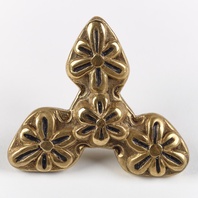
Viking Objects
Reproduction Trefoil Mount
A reproduction of copper alloy and gilded Carolingian mount with niello inlay found in Leicestershire. The mount has holes drilled through it for affixing to a surface, possibly a book, or perhaps to repurpose it as a pendant. These would have most likely been brought over by Vikings who had raided or traded on the European continent.
Read More
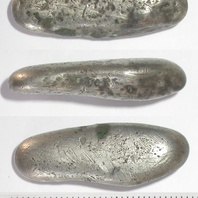
Viking Objects
Silver Ingot (DENO-CE6103)
This silver ingot was made by melting down worked silver and casting it in an open mould. The Vikings arriving in England had a bullion economy in which they paid for goods with silver that was weighed to an amount agreed between the buyer and the seller. Hacksilver and silver ingots are the most common evidence for their bullion economy. It took some time for the Scandinavian settlers to adopt a monetary economy like that of the Anglo-Saxons, and both systems were used simultaneously for a while before they fully adopted the new system. The Vikings were familiar with monetary economies but they treated coins as just another form of silver before adoption of a monetary economy.
Read More
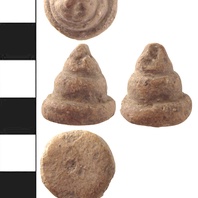
Viking Objects
Cast Lead Weight (SWYOR-A48576)
A cast lead-alloy weight or possible gaming piece in the form of a cone made of three levels. It is perhaps an indicator of the Scandinavian bullion economy. Weights are an important form of evidence for Viking Age commerce and the use of standards across the different economic systems within which Vikings were integrated. Many of the weights discovered, particularly ones in Ireland and those of Arabic type, suggest that a standardized system of weights existed in some areas. These standard weights, alongside standard values of silver, are what allowed the bullion economy of Viking occupied areas to function. A bullion economy was a barter economy that relied on the exchange of set amounts of precious metal in various forms, such as arm-rings or coins, for tradable goods, such as food or textiles. Each merchant would have brought their own set of weights and scales to a transaction to make sure that the trade was conducted fairly.
